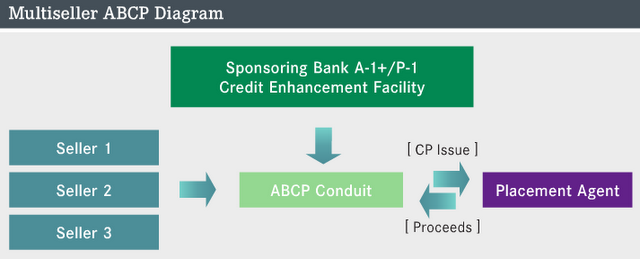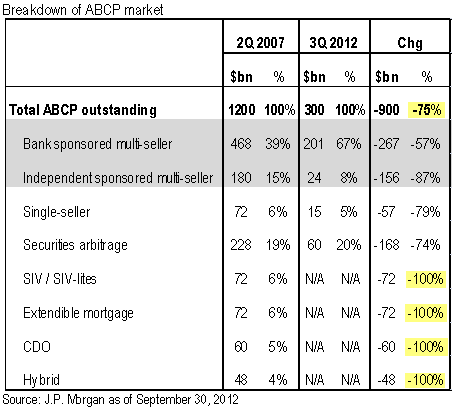After reaching its peak of over $1.2 trillion reached in 2007, Asset Backed Commercial Paper (ABCP) outstanding has continued its decline. The rapid growth was originally triggered by the use of commercial paper to fund RMBS, CDO bonds, SIVs, etc. But in early 2007, as subprime defaults picked up, US money market funds stopped buying ABCP, forcing banks who backstopped the commercial paper programs to move CDO bonds, etc. onto their balance sheets (that's the sharp decline in late 2007 on the chart below). This is what ultimately caused Citibank and Wachovia to become insolvent.
The ABCP market has undergone a dramatic change since then. Most of the programs are now so-called bank sponsored multi-seller facilities (multiple issuers use the CP program to fund their assets) - which provides some diversification. And the assets funded are much simpler these days - generally short-term ABS (autos, cards, etc.)
JPMorgan: - Today, the ABCP market comprises mainly of plain vanilla, traditional multi-seller conduits. Gone are the days when the market included more-sophisticated structures such as SIVs (structured investment vehicles) or securities arbitrage conduits. Although there are some securities arbitrage programs still outstanding, most are in the process of winding down as they let their securities run off. These are securities such as RMBS, CMBS, and CDOs, which most sponsors/investors would rather not continue to fund. Indeed, based on data we collected from our partners in banking, 75% of the ABCP market today comprises multi-seller conduits sponsored by banks or independent companies versus 54% five years ago — a reflection of investors’ preference for this type of structure. 
However even the multi-seller programs are shrinking. The sharp declines in ABCP this year have been driven by the Eurozone crisis, as money market funds no longer fund programs set up by French, German and UK banks in the US. No money market fund wants to show European exposure on its regular investor reports - even exposure to stronger EU institutions. Japanese, Canadian, and US banks, particularly Citibank, continue to manage some of the active ABCP programs.
JPMorgan: - It’s not surprising then that the largest ABCP programs currently are multi-seller conduits sponsored by US, Canadian, and Japanese banks—credits that investors have sought after away from the Eurozone. These programs continue to benefit from better pricing and market access compared to European administrators. For example, an A- 1/P-1 US ABCP conduit could obtain 1 [month] funding around 15bp (LIBOR - 5bp) versus an A-1/P-1 French ABCP conduit around 25-35bp (L + 5/15bp). Even Citigroup (A1/P- 2/F1) remains the largest overall and US sponsor of multiseller conduits. They currently fund below the French conduits in 1 [month maturity]. With that said, [Citibank's] funding capacity would likely be severely limited if they suffer any more ratings erosion such that they become a Tier 2 issuer.
Banking organizations in the US with strong ratings will continue to run relatively small ABCP programs. They are quite useful to facilitate non-bank consumer lending (a form of "shadow banking"). Often if you buy or lease a car in the US, the loan or lease ultimately becomes part of an ABS and is financed with ABCP. But the ABCP market is now a shadow of its former self and the amount outstanding continues to decline to new lows.
- English (UK)
- English (India)
- English (Canada)
- English (Australia)
- English (South Africa)
- English (Philippines)
- English (Nigeria)
- Deutsch
- Español (España)
- Español (México)
- Français
- Italiano
- Nederlands
- Português (Portugal)
- Polski
- Português (Brasil)
- Русский
- Türkçe
- العربية
- Ελληνικά
- Svenska
- Suomi
- עברית
- 日本語
- 한국어
- 简体中文
- 繁體中文
- Bahasa Indonesia
- Bahasa Melayu
- ไทย
- Tiếng Việt
- हिंदी
Asset Backed Commercial Paper Market Declines To New Lows
Published 10/28/2012, 03:55 AM
Updated 07/09/2023, 06:31 AM
Asset Backed Commercial Paper Market Declines To New Lows
3rd party Ad. Not an offer or recommendation by Investing.com. See disclosure here or
remove ads
.
Latest comments
Install Our App
Risk Disclosure: Trading in financial instruments and/or cryptocurrencies involves high risks including the risk of losing some, or all, of your investment amount, and may not be suitable for all investors. Prices of cryptocurrencies are extremely volatile and may be affected by external factors such as financial, regulatory or political events. Trading on margin increases the financial risks.
Before deciding to trade in financial instrument or cryptocurrencies you should be fully informed of the risks and costs associated with trading the financial markets, carefully consider your investment objectives, level of experience, and risk appetite, and seek professional advice where needed.
Fusion Media would like to remind you that the data contained in this website is not necessarily real-time nor accurate. The data and prices on the website are not necessarily provided by any market or exchange, but may be provided by market makers, and so prices may not be accurate and may differ from the actual price at any given market, meaning prices are indicative and not appropriate for trading purposes. Fusion Media and any provider of the data contained in this website will not accept liability for any loss or damage as a result of your trading, or your reliance on the information contained within this website.
It is prohibited to use, store, reproduce, display, modify, transmit or distribute the data contained in this website without the explicit prior written permission of Fusion Media and/or the data provider. All intellectual property rights are reserved by the providers and/or the exchange providing the data contained in this website.
Fusion Media may be compensated by the advertisers that appear on the website, based on your interaction with the advertisements or advertisers.
Before deciding to trade in financial instrument or cryptocurrencies you should be fully informed of the risks and costs associated with trading the financial markets, carefully consider your investment objectives, level of experience, and risk appetite, and seek professional advice where needed.
Fusion Media would like to remind you that the data contained in this website is not necessarily real-time nor accurate. The data and prices on the website are not necessarily provided by any market or exchange, but may be provided by market makers, and so prices may not be accurate and may differ from the actual price at any given market, meaning prices are indicative and not appropriate for trading purposes. Fusion Media and any provider of the data contained in this website will not accept liability for any loss or damage as a result of your trading, or your reliance on the information contained within this website.
It is prohibited to use, store, reproduce, display, modify, transmit or distribute the data contained in this website without the explicit prior written permission of Fusion Media and/or the data provider. All intellectual property rights are reserved by the providers and/or the exchange providing the data contained in this website.
Fusion Media may be compensated by the advertisers that appear on the website, based on your interaction with the advertisements or advertisers.
© 2007-2024 - Fusion Media Limited. All Rights Reserved.
